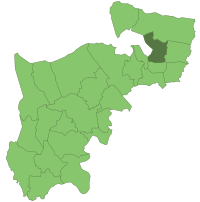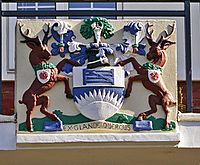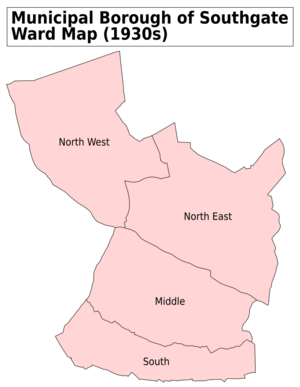Municipal Borough of Southgate facts for kids
Quick facts for kids Southgate |
|
| Motto: Ex glande, quercus (From the acorn, the oak) | |
 Southgate Town Hall |
|
 Southgate within Middlesex in 1961 |
|
| Geography | |
| Status | Local board (1881-1894) Urban district (1894-1933) Municipal borough (1933-1965) |
| HQ | Southgate Town Hall, Palmers Green |
| History | |
| Created | 1881 |
| Abolished | 1965 |
| Succeeded by | London Borough of Enfield |
 Coat of arms of the Municipal Borough of Southgate |
|
Southgate was a special area in Middlesex, England. It had its own local government from 1881 to 1965. This means it managed its own local services and rules. Southgate was also part of the London postal district and the area covered by the Metropolitan Police District.
Contents
How Southgate Grew and Changed
Southgate was originally part of a larger area called Edmonton. In 1850, Edmonton set up a "local board of health." This board helped manage things like public health and sanitation.
Becoming Separate
In 1879, people living in Southgate wanted their area to be separate. They asked for their own local government. So, in 1881, the Southgate Local Board was created. It had nine members who made decisions for the area.
Becoming an Urban District
Later, in 1894, Southgate became an urban district. This was under a new law called the Local Government Act 1894. An urban district had more power to manage local services. By 1900, the council for Southgate grew to 12 members.
Becoming a Municipal Borough
In 1933, Southgate got an even bigger upgrade. It became a "municipal borough." This meant it had its own mayor, seven aldermen, and 21 councillors. They worked together to run the borough.
Joining Greater London
However, in 1965, big changes happened in London. The London Government Act 1963 was passed. This law changed how local areas were governed. Southgate's municipal borough was ended. Its area became part of Greater London. Southgate joined with the Municipal Borough of Enfield and the Municipal Borough of Edmonton. Together, they formed the new London Borough of Enfield that we know today.
Areas Within Southgate
The Southgate borough included several well-known areas. These were Southgate itself, Palmers Green, and Winchmore Hill. It also included Arnos Grove, New Southgate, and parts of Oakwood. Other parts were Cockfosters, Bounds Green, and Bowes Park. The main office for the borough was the Southgate Town Hall. It is located on Green Lanes in Palmers Green.
Southgate's Coat of Arms
Southgate received its own special coat of arms on September 15, 1933. This happened when it became a municipal borough. A coat of arms is a unique design that represents a place or family.
What the Arms Looked Like
The main shield of the arms was blue. It had a shining sun rising from the bottom. At the top, on a gold band, there was a gate with four bars. The "crest" (the part above the shield) showed an oak tree with acorns. Hanging from the tree were a hunting horn and a quiver of arrows, both gold.
The Supporters
On each side of the shield, there was a stag (a male deer). Each stag had a wreath of oak leaves around its neck. From the wreath hung a small gold shield with a red rose on it. The motto was in Latin: "Ex glande, quercus." This means "From the acorn, the oak."
What the Symbols Meant
The coat of arms had special meanings. The sun was there to represent "south." When combined with the "gate," it made up the name "Southgate." The oak tree and the stags reminded people of the old oak forests in the area. The red roses showed that Southgate was part of the Duchy of Lancaster.
You can still see this coat of arms today. It is carved into the front of a block of flats on Reservoir Road. This is near Oakwood tube station.


